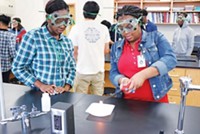Advertisement
Grab your lab coat. Let's get started
Welcome!
Welcome!
Create an account below to get 6 C&EN articles per month, receive newsletters and more - all free.
It seems this is your first time logging in online. Please enter the following information to continue.
As an ACS member you automatically get access to this site. All we need is few more details to create your reading experience.
Not you? Sign in with a different account.
Not you? Sign in with a different account.
ERROR 1
ERROR 1
ERROR 2
ERROR 2
ERROR 2
ERROR 2
ERROR 2
Password and Confirm password must match.
If you have an ACS member number, please enter it here so we can link this account to your membership. (optional)
ERROR 2
ACS values your privacy. By submitting your information, you are gaining access to C&EN and subscribing to our weekly newsletter. We use the information you provide to make your reading experience better, and we will never sell your data to third party members.
Safety
Lights, Camera, Chemistry
Learning how to make lab demonstration videos can pay off for instructors and students
by Carmen Drahl
February 8, 2010
| A version of this story appeared in
Volume 88, Issue 6

The formulas on the blackboard usually held his attention, but sometimes Pedro A. Bueno couldn't help but get distracted—a glint of light from a shiny metal casing here, a tiny pair of white earbuds there. Bueno, a chemistry graduate student at the University of Maryland, was observing a general chemistry course and trying to come up with a nontraditional teaching method to fulfill the requirements of his teaching fellowship. While he sat in on one of the lectures, he realized the idea he needed was right under his nose.
"I would look around and I'd see all these students with iPods," Bueno recalls. The devices are a convenient form of media, and people already take them everywhere, he figured, so why not use them in his teaching?
The result was a series of brief video podcasts to guide students through the unfamiliar world of the lab, from learning how glassware is calibrated to performing titrations.
Videotaping lab-related lectures is certainly nothing new. But with the advent of compact, portable video players such as the iPhone and iPod and online media hubs such as YouTube, video instruction is getting renewed attention from professors and students alike.
Although it takes time and effort to learn to produce videos, instructors who spoke with C&EN believe the benefits are worth it. By showing what to expect in lab, videos increase students' confidence and independence. Videos also free up "face time" for instructors to address questions that go beyond the basics.
Traditionally, undergraduate students have prepared for a chemistry lab by reading material from a textbook or handout beforehand. But "textbooks don't always do an adequate job of describing techniques," says organic chemist Rick L. Danheiser of Massachusetts Institute of Technology, who spearheaded the development of MIT's Digital Lab Techniques Manual, an online collection of videos about distillation, recrystallization, and other procedures.
Once students arrive in the lab, an instructor gives a prelab lecture, demonstrating the techniques to be used in the experiment. But it can be a lot to ask of many students, who aren't familiar with the language of the lab, to perform complicated experiments after having seen the techniques only once, says Haim Weizman, a chemistry professor at the University of California, San Diego, who has developed online instructional videos on organic chemistry techniques such as extractions.
"You can't pause a prelab lecture," adds Bonnie Dixon, a lecturer at Maryland who collaborated with Bueno on producing video podcasts. But students can pause and replay portable videos anywhere, anytime.
The technical hurdles to producing an instructional lab video might seem daunting to an instructor. But chemists tell C&EN that they were able to cope by teaching themselves what they needed to know or seeking out technical resources within their universities.
For instance, at Indiana University's South Bend campus, chemists Gretchen Anderson and Doug McMillen teamed up with Jim Yocom, the university's director of instructional media services. Their video podcasts for organic chemistry cover topics such as gravity filtration. Videos for biochemistry labs include a step-by-step guide to gel electrophoresis, from removing a premade gel from its package to plugging electrodes into the electrophoresis chamber correctly. The team purchased dedicated video iPods for the labs and disabled the devices' Internet access to discourage students from using them for noneducational purposes. Students check iPods out at the beginning of lab and check them back in at the end.
At Maryland, Bueno teamed up with Wendy Heiserman, another graduate fellow who was interested in video instruction. He developed lab-technique video podcasts, and she created postlab videos to reinforce chemical concepts and data analysis with spreadsheets. "Because of our different teaching experiences, we saw different deficits" that videos might address, Heiserman says. In a subsequent semester, Heiserman branched out to prelab videos.
Cynthia Powell, on the other hand, was a one-woman production studio. Powell coordinates the general chemistry curriculum at Abilene Christian University (ACU), a private college in Abilene, Texas. She developed video podcasts on filtration, titration, and more for the iPhone and iPod Touch. Every student gets one of those devices upon enrolling at ACU, thanks to the school's Mobile Learning Initiative. And the institution has been generous with providing resources for exploring the technology, Powell says.
Before the cameras start rolling, lining up funding is key. Instructors should figure out what resources they and their departments already have and determine a budget from there, Powell recommends.
See videos explaining how to work with pyrophoric reagents, such as tert-butyllithium, at www-chem.ucsd.edu/pyrophoric
At a bare minimum, what's needed is a digital camcorder for recording the video and software for editing footage. Big video files eat up hard-drive space, so an external drive is another consideration. Money might also be needed to pay students or professionals involved in the project. Podcast distribution and download is free at the online media store iTunes U, and it's also possible to host videos on a departmental website or a video hub such as SciVee.tv or YouTube. Depending on how students access videos, good wireless coverage may also be essential.
If dedicated iPods will be in the budget, consider protective cases that are resistant to chemical spills, Anderson says. But it's not always possible or desirable to provide iPods for every student, so in such cases, the videos must also be compatible with viewing on multiple devices, including a computer screen.
Most researchers who spoke with C&EN obtained funding from their universities, although many noted that current academic belt-tightening can make it tough to get started or to film additional videos. Weizman's funds came from UCSD's safety committee. Danheiser teamed with then-MIT instructor Sarah A. Tabacco, who played a key role in creating the first videos, to obtain support from an MIT alumni fund for education. Bueno's and Heiserman's stipends were paid for by a Graduate Assistance in Areas of National Need fellowship from the U.S. Department of Education. Budgets themselves varied widely, from a few hundred dollars to more than $10,000.

Once funding is in place, developing scripts in the traditional sense isn't critical, Weizman says. "I prefer to write a rough outline and then show it to my colleagues and ask for comments," he says. For his latest project, Weizman developed instructional videos for transferring pyrophoric reagents such as tert-butyllithium from a sealed bottle to a reaction flask. What is important, especially for potentially dangerous procedures, is to make sure a video doesn't just encourage mimicking, he says. Be brief, but get students thinking about the meaning behind each manipulation, he advises.
Feedback is important throughout the process, ACU's Powell says. She set up a diverse focus group to advise her during and after production. For more quantitative feedback, she split labs into a "video" section and a "nonvideo" section that had only traditional prelab lectures. Her early results suggest that students who watch instructional videos need fewer interactions with teaching assistants.
For Erin Boyd, a sophomore biology major at ACU, Powell's work translated to an increase in the quality of her interactions. The videos "allowed us to discuss higher level things and get past the mechanics of what we were doing," she says.
At Maryland, most students found the videos helpful, but some thought a few videos were too long, Dixon says. "It's important to try to narrow the focus of what you're trying to get across," she says.
Bueno adds that if he could do things over, he'd invest in better filming equipment to boost the videos' production quality.
At IU South Bend, senior biochemistry major Gabrielle Johnson says the videos helped her catch up with more experienced classmates. The technology "really gave me confidence to go in and enjoy lab because I was able to keep up with the pace," she says. And Anderson feels like she's repeating instructions far less often these days. Instead, more students are asking in-depth questions about the meaning behind experiments, something that's extremely gratifying as an instructor, she says. "Now, lab is way more fun for me, too."





Join the conversation
Contact the reporter
Submit a Letter to the Editor for publication
Engage with us on Twitter